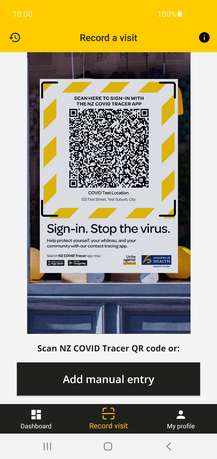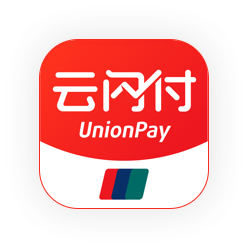
A barcode or bar code is a method of representing data in a visual, machine-readable form. Initially, barcodes represented data by varying the widths, spacings and sizes of parallel lines. These barcodes, now commonly referred to as linear or one-dimensional (1D), can be scanned by special optical scanners, called barcode readers, of which there are several types.

Mobile payment, also referred to as mobile money, mobile money transfer and mobile wallet, is any of various payment processing services operated under financial regulations and performed from or via a mobile device. Instead of paying with cash, cheque, or credit card, a consumer can use a payment app on a mobile device to pay for a wide range of services and digital or hard goods. Although the concept of using non-coin-based currency systems has a long history, it is only in the 21st century that the technology to support such systems has become widely available.

A barcode reader or barcode scanner is an optical scanner that can read printed barcodes, decode the data contained in the barcode on a computer. Like a flatbed scanner, it consists of a light source, a lens, and a light sensor for translating optical impulses into electrical signals. Additionally, nearly all barcode readers contain decoder circuitry that can analyse the barcode's image data provided by the sensor and send the barcode's content to the scanner's output port.
Commercial Bank of Ceylon PLC (CBC) also known as ComBank is a licensed commercial bank in Sri Lanka and its ownership is private. It was incorporated as a public limited company and it is listed on the Colombo Stock Exchange. It is regarded as the largest private bank in Sri Lanka in terms of net worth and capital. The bank is currently the third largest bank in Sri Lanka in terms of total net assets and it lies behind only Bank of Ceylon and People's Bank. It is also the only private sector licensed bank in Sri Lanka to be designated as the higher-tier domestic systemically important bank according to the Central Bank of Sri Lanka. The bank currently operates a network of 268 branches and around 932 ATM machines across Sri Lanka.

A QR code is a type of two-dimensional matrix barcode, invented in 1994, by Japanese company Denso Wave for labelling automobile parts. A QR code consists of black squares arranged in a square grid on a white background, including some fiducial markers, which can be read by an imaging device, such as a camera, and processed using Reed–Solomon error correction until the image can be appropriately interpreted. The required data are then extracted from patterns that are present in both the horizontal and the vertical components of the QR image.

Electronic funds transfer (EFT) is the electronic transfer of money from one bank account to another, either within a single financial institution or across multiple institutions, via computer-based systems, without the direct intervention of bank staff.

Network for Electronic Transfers, colloquially known as NETS, is a Singaporean electronic payment service provider. Founded in 1986 by a consortium of local banks, it aims to establish the debit network and drive the adoption of electronic payments in Singapore. It is owned by DBS Bank, OCBC Bank and United Overseas Bank (UOB).

Windows Live Barcode was a part of Microsoft's Windows Live services. It allowed users to transfer information between various media and handsets via Quick Response Code, a two-dimensional matrix barcode. It provided a method for people to exchange information and use various online services on handsets.

Andhra Pradesh State Road Transport Corporation, officially Andhra Pradesh Raastra Roadu Ravaana Samstha, is the state-owned road transport corporation in the Indian state of Andhra Pradesh. Its headquarters is located at NTR Administrative Block of RTC House in Pandit Nehru bus station of Vijayawada. Many other Indian metro towns in Telangana, Tamil Nadu, Karnataka, Odisha, Yanam, Kerala, Maharashtra and Chhattisgarh are also linked with the APSRTC services.
Mobile tagging is the process of providing data read from tags for display on mobile devices, commonly encoded in a two-dimensional barcode, using the camera of a camera phone as the reader device. The contents of the tag code is usually a URL for information addressed and accessible through Internet.
Merchant Customer Exchange (MCX) was a company created by a consortium of U.S. retail companies to develop a merchant-owned mobile payment system, which was to be called "CurrentC." The joint venture was announced on August 15, 2012.

Unified Payments Interface, commonly referred to as UPI, is an Indian instant payment system as well as protocol developed by the National Payments Corporation of India (NPCI) in 2016. The interface facilitates inter-bank peer-to-peer (P2P) and person-to-merchant (P2M) transactions. It is used on mobile devices to instantly transfer funds between two bank accounts. The mobile number of the device is required to be registered with the bank. The UPI ID of the recipient can be used to transfer money. It runs as an open source application programming interface (API) on top of the Immediate Payment Service (IMPS), and is regulated by the Reserve Bank of India (RBI). Indian Banks started making their UPI-enabled apps available on Google Play on 25 August 2016.

BharatQR, developed by NPCI, Mastercard, and Visa, is an integrated payment system in India for mobile device. The system was launched in September 2016. It facilitates users to transfer their money from one source to another. The money transferred through BharatQR is received directly in the user's linked bank account. It provides a common interface between RuPay, Mastercard, Visa and American Express, and is interoperable with all the banks. Currently, BharatQR is supported on both Android and iOS devices.
QR code payment is a contactless payment method where payment is performed by scanning a QR code from a mobile app. This is an alternative to doing electronic funds transfer at point of sale using a payment terminal. This avoids a lot of the infrastructure traditionally associated with electronic payments such as payment cards, payment networks, payment terminal and merchant accounts.

NZ COVID Tracer is a mobile software application that enables a person to record places they have visited, in order to facilitate tracing who may have been in contact with a person infected with the COVID-19 virus. The app allows users to scan official QR codes at the premises of businesses and other organisations they visit, to create a digital diary. It was launched by New Zealand's Ministry of Health on 20 May 2020, during the ongoing COVID-19 pandemic. It can be downloaded from the App Store and Google Play.

vcash was a Malaysian digital wallet and online payment platform established in Shah Alam in November 2017, by Digi Telecommunications, a subsidiary of Telenor Group. vcash allowed users to make payments in local stores via a QR code, pay bills, top-up prepaid mobile phones, and do P2P transfers. Despite being a Digi product, user registration and usage of this service was opened to both Digi and non-Digi customers. Its competitors were GrabPay, Touch 'n Go eWallet, and Axiata's Boost. On 1 November 2019, Digi announced they were discontinuing vcash on 30 November 2019, two years after its launch, which were attributed to stiff competition from competitors that provide rewards to their users to retain customers in their services.
Contactless dining is a restaurant dine-in experience that allows a guest to view the menu, place orders, and make payments without interacting closely with a server or touching shared public surfaces. The form of dining has emerged in global popularity during the COVID-19 pandemic.
LeaveHomeSafe is a digital contact tracing app launched by the Hong Kong Government on 16 November 2020 to conduct contact tracing in Hong Kong. It can be used as a companion of the Hong Kong Health Code system for registered users.

The app of UnionPay is a mobile and online payment service, developed and operated by UnionPay, the national Chinese bank card clearing service. Launched in 2017, it was designed to compete with the existing third-party Chinese mobile payment platforms, Alibaba Group's Alipay and Tencent's WeChat Pay. The mobile app allows the user to add their UnionPay bank card, and use it for various types of online and mobile payments, including in-app online payments, QR code payments, as well as contactless payments on NFC-enabled devices using UnionPay's QuickPass feature.
The NZ Pass Verifier is a free mobile app developed by the New Zealand Ministry of Health for businesses and organisations to scan and verify their customers' My Vaccine Pass certificates. The app was launched on 23 November 2021 for use on smartphones.













